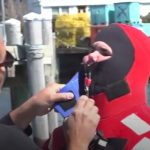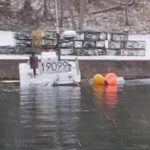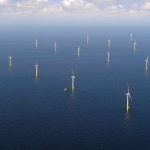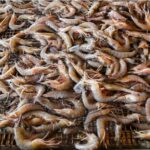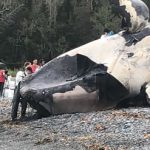Tag Archives: Factory trawlers
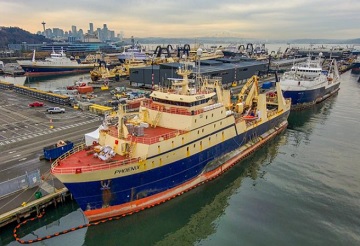
All About the Fishing Fleet at Terminal 91
The factory trawlers, or fish processing vessels, of the North Pacific Fishing Fleet are back in Seattle after four months of harvesting pollock in the Bering Sea and Gulf of Alaska. The docks at Terminal 91 are buzzing with activity as crews unload their recent harvest and prepare to set sail again in late May. For more than 100 years, the North Pacific Fish Fleet, homeported at Terminal 91 and Fishermen’s Terminal, has fed the world and the economies of the Pacific Northwest and state of Alaska. Our region supplies 13% of the total U.S. commercial fisheries harvest by value. Commercial fishing activities at the Port of Seattle generated more than $671.2 million in business output in 2017 and supported 7,200 jobs. Learn more about the North Pacific Fishing Fleet, photos, >click to read< 10:16
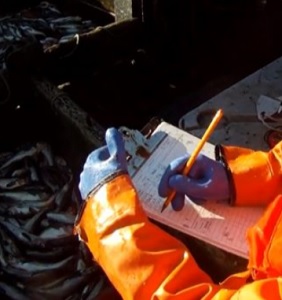
‘Trapped’: Women Working as Fishery Observers Allege Sex Harassment, Assault at Sea
She had overcome the seasickness, the unreliable shifts, and the long hours that drive many people out of the business. But she didn’t sign up for 3 1/2 weeks of harassment. On the ship that served as both her workplace and temporary home, Kim, then in her mid-20s, was constantly catcalled, hit on, and leered at, with no place to escape. Four women, including Kim, who worked on the front lines of fisheries monitoring in Canada, say they were dropped into a hellish grind of sexual harassment, assault, intimidation, threats, and horrifying animal abuse while they watched helplessly. >click to read< 10:15

Tax appeal challenges Alaska’s fish landing tax
A tax dispute between a single fishing company and the state of Alaska could have far-reaching consequences for fishing towns across the state. Each year, fleets of factory trawlers and offshore processors catch millions of tons of fish in the North Pacific and Bering Sea. This happens outside the 3-mile limit that marks Alaska waters. But it isn’t practical to off-load their catch in the open ocean. So it’s almost always done in an Alaska ports or onto a transport ship anchored in state waters. It’s at this point that the state of Alaska takes its cut. click here to read the story 11:35

Fishermen in the north-east Atlantic: living at the pace of the trawl catch
Huge factory trawlers plough the various fisheries, depending on the product sought, to supply major distribution outlets. This large-scale commercial fishing, also known as industrial fishing, is heavily subsidised by public funds. The industrial trawlers of today are out-and-out floating factories where the work is wholly designed and organised around production line methods. The seafarers remain at their workplace for 27 days. During this time, their lives, eating and sleep patterns depend on the work to be done. The north-east Atlantic is the world’s fourth largest fishery. Mainly exploited by European ship owners, this area accounts for over 70 per cent of EU catches. Photojournalist Pierre Vanneste spent two 15-day stretches at sea with industrial fishermen, to report on the day-to-day reality of life on board. Read the story here 20:35
Factory trawlers praised for halibut conservation
 What a difference a year makes for the halibut bycatch controversy in the Bering Sea at the December meetings of the North Pacific Fishery Management Council in Anchorage. The flatfish factory trawlers, vilified for much of this year, reported vigorous and voluntary efforts at halibut conservation, and even received praise from the Pribilofs. Their zeal was prompted by what might be termed resolution number two-by-four of the fish council last summer, which slashed halibut bycatch by 25 percent. “I’m glad what is happening now is happening,” said Swetzof, who was furious when the issue first arose last year,,, Read the article here 18:32
What a difference a year makes for the halibut bycatch controversy in the Bering Sea at the December meetings of the North Pacific Fishery Management Council in Anchorage. The flatfish factory trawlers, vilified for much of this year, reported vigorous and voluntary efforts at halibut conservation, and even received praise from the Pribilofs. Their zeal was prompted by what might be termed resolution number two-by-four of the fish council last summer, which slashed halibut bycatch by 25 percent. “I’m glad what is happening now is happening,” said Swetzof, who was furious when the issue first arose last year,,, Read the article here 18:32
Bering Sea trawler deaths highlight Arctic fishing, shipping issues
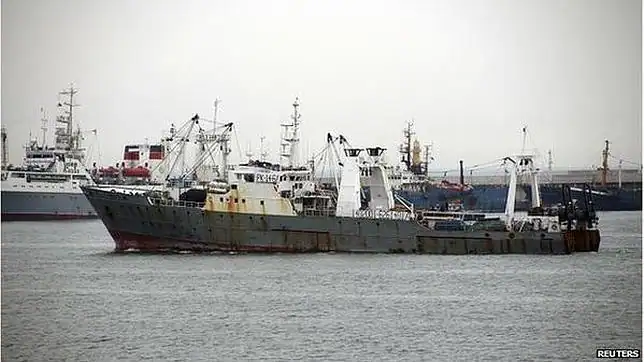 Early in the morning of Dec. 2, the factory trawler Oryong 501 sank into the frigid depths of the Bering Sea off of Russia’s east coast. A large wave hit the vessel as it hauled in a catch of pollock. Though the ship was South Korean-flagged, BBC News reports that 35 Indonesians, 13 Filipinos, 11 South Koreans and one Russian inspector were onboard at the time of the sinking; so far, 27 have been confirmed dead and 8 rescued, with the others missing. Read the rest here 19:20
Early in the morning of Dec. 2, the factory trawler Oryong 501 sank into the frigid depths of the Bering Sea off of Russia’s east coast. A large wave hit the vessel as it hauled in a catch of pollock. Though the ship was South Korean-flagged, BBC News reports that 35 Indonesians, 13 Filipinos, 11 South Koreans and one Russian inspector were onboard at the time of the sinking; so far, 27 have been confirmed dead and 8 rescued, with the others missing. Read the rest here 19:20




































